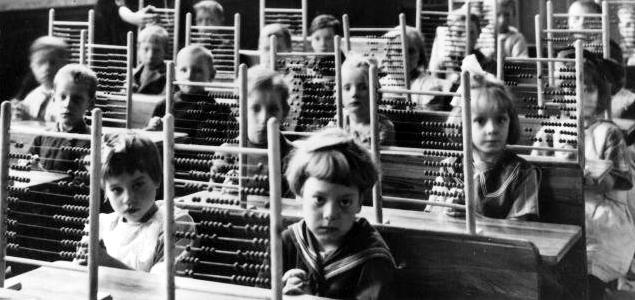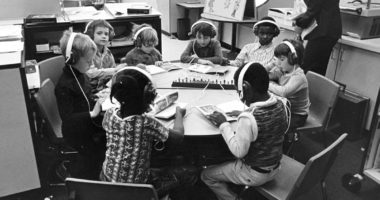
Pupils with counting-frames in classroom, about 1930. Source: National Archief
The need to change the school system has been on the cards for some time. Perhaps now it has become urgent. The arguments for this can be summarised in three broad groups: schools do not teach students how to function in today’s world; they teach as though knowledge were separate from the digital world; and, increasingly, they no longer humanize students, thus exacerbating the effects of social selection. Nonetheless, it is not easy to reach broad agreements on what to change and how to change it. This article offers four suggestions regarding the foundations that should underpin learning and education today.
It has become fashionable to say that “the school system needs to change”, even though the claim is often an empty statement that is either meaningless or based on contradictory reasons and aspirations, or on rather inconsistent opinions. For academic authorities, it may simply be about making changes to improve our student’s PISA test scores. And then there is a section of society that suggests changing things because kids these days know very few of the things that we were always told they needed to know. And a significant number of teachers argue that change is necessary because students are wayward and no longer accept their attempts to teach them things they consider irrelevant.
From skills to humanisation
The list of motives (not necessarily coherent reasons) is much longer. But if we want change, we need to agree on why, and as such I suggest working with three reasons (or groups of reasons). Firstly, the school system has to change because it does not provide or encourage the skills (the grounding) students require to become citizens in today’s world. The second reason springs from realising that current ways of teaching and learning are disconnected from the information or digital society. And thirdly, schools have to change because they are no longer the primary space of humanization (or better still, we urgently need them to be so, as UNESCO has recently reminded us).
Change is necessary because we need our school system to motivate students to acquire the “user manuals” for an increasingly complex society. We also need our school system to be the centrepiece of myriad ways of learning, in a context influenced by the world of 2.0. We must make sure we hang on to a school system based on knowledge, on the paradigm of reasoning, doubt, and an open process of answers for a global and diverse world in which there should be no room for dogma or for the justification of injustice.
Some people are calling for change in the grip of bewilderment about education. Others seek change because they think that schools are no longer helping to sustain their society. This means that some proposals for a “new” school system come from powerful movements that suggest going backwards (back to the basics): “Let’s make traditional schooling work today,” they say. For example, some of the anti-reformist proposals revolve around the battle of the school curriculum (making sure that it determines the things that all students have to know).
The proposals for genuine renewal are based on new forms of organisation, new pedagogies and new didactics that can radically transform the existing school system. Though we should note that not all of these proposals take the third group of reasons into account, or that their approach to them is the opposite of the one I have suggested. For example, one of the proposals that circulated widely this academic year was the “Horizonte 2020” programme proposed by the Jesuit schools. The programme is far-reaching and organisationally sound, but it is based on maintaining a certain degree of social inequality and it does not renounce religious indoctrination. It is possible to be radically innovative in pedagogic terms and at the same time conservative in educational terms. In fact, the impossible education pact (usually defined as an agreement to not pass further education laws) is not really about what to teach and how to make learning possible today. It is more about the need to agree on what schools should be for, now and in the future, and particularly about how to approach social inequality and human diversity in childhood and adolescence.
Current proposals for radical change follow several decades of denial of pedagogies, of a struggle for logic in regard to subjects, and of classification and labelling of students. It is interesting to note how many “new” proposals had already been discovered and applied (in a different context) in the main 20th century pedagogies and are now being reformulated in 21st century pedagogies. Today’s fast-changing, complex, hybrid societies draw attention to the inescapable need to formulate a new school system. Interestingly, new social situations are bringing back old educational innovations that some people had wanted to discard (such as project-based schoolwork, for example).
Negotiated changes and agreement on the minimum degree of exclusion
Social complexity, which in turn becomes educational complexity, has also strengthened two conflicting proposals for renewal. On one hand, proposals based on equality put forth by modern schools, which aspire to contribute to building a fairer society. On the other, proposals based on segregation, which aim to create new successful schools by separating students early on, assuming that they are already unequal when they start school. To openly create flexible groups (getting rid of classes and courses, for example), or to separate students into different academic itineraries early on. Now as in the past, it seems like a gargantuan task to expect that the school institution (even after a process of renewal) should stop being at the service of segregation.
What school renewal agreements are inevitable? I suggest thinking in terms of four groups:
- Where does learning take place today? Even if we agree that school is not the principal place of learning, this does not mean that schools should disappear. Instead, we should think about what to do to ensure that schools become the key point of reference for learning. We also need to ensure that schools become the main benchmark for “life normality” during all of childhood. The crucial point is still about creating schools that are linked to their communities (face-to-face and virtually), starting with an open building, and using school surroundings and resources as places of learning.
- We should set aside the notion that the role of schools is to offer instruction or the transmission of knowledge. Let us define school as the institution that significantly looks after the part of education that has to do with access to knowledge; as the place that arouses and nurtures curiosity; the place that stimulates questions and helps find answers; the place that helps children and teenagers to integrate all the different types of knowledge that is learnt in different places and different formats. We should long have discarded the idea of subjects, for example.
- Let us classify the most useful ways of learning today, making it clear how people learn (consider the well-known Seven Principles of Learning, for example). Networked and group learning prevails in the internet age, and it can become a collaborative process that generates active creation. This reasonably entails getting rid of books, closed classes, and master classes based on the teacher’s discourse as a universal format.
- The school that contributes to making students citizens of today’s society is the school of people, as a whole. The school of feelings and emotions. The school in which students discover the other, and where it is impossible to learn without learning to live together. And this school is also – as it always should have been – the place of scientific thought and creative production. The place that allows students to discover the answers to questions about the world that human beings have asked in the course of history, and that stimulates the search for new answers. Moreover, school is always the place that has no room for dogma and allows students to acquire a critical attitude.
It is not necessary to mention Finland in order to innovate. We simply need to stop turning a blind eye to the evidence that the official school system is increasingly disconnected from the realities of childhood and adolescence.





Leave a comment